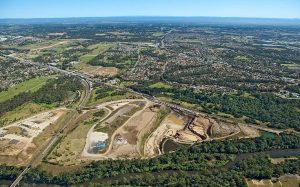
Despite a big legal victory in the Land and Environment Court, anti intermodal crusader John Anderson says the fight must go on.
The chairman of Residents Against Intermodal Development (RAID) Inc says the court imposed conditions on noise, air quality and biodiversity are welcome but don’t go far enough.
Mr Anderson, a Wattle Grove resident who has been part of the campaign against the Moorebank intermodal for almost 10 years, says the court decision was a “step on the right track’’.
“Our ultimate aim is still to stop the project in its tracks,’’ he tells the Voice over the phone this morning.
“The conditions imposed by the court are welcome but if we are being fair dinkum on noise mitigation, 17,000 homes would need to have double glazing installed.
“I don’t think Qube [intermodel proponents] would chip in to pay for something like that,’’ Mr Anderson said.
“And then there’s the question of a koala habitat on the site and around it at Holsworthy army camp.
“We need to have this seriously investigated to see what sort of mitigation measures may be needed to protect them from the operation of the intermodal.’’
Mr Anderson said RAID Inc would push on against the intermodal and was currently considering various strategies.
[social_quote duplicate=”no” align=”default”]“We’re not giving up,’’ he said.[/social_quote]
In the Land and Environment Court, in the case between RAID v Qube, this is what Senior Commissioner Susan Dixon said in the judgment:
“I am satisfied that RAID through this litigation has achieved a more stringent set of conditions which respond to many of the concerns raised by the lay witnesses and the expert evidence as it presently stands.”
Biodiversity:
- Qube have to prepare and implement a survey plan for Hibbertia species to identify how any endangered plants there are within the rail corridor and ensure an appropriate offset for any impacted plants.
- Qube have to remove the disused rail spur on the offset “boot” land on the site, and have to rehabilitate that land. Within two months of completing that rehabilitation process, they have to amend the biobanking agreement to include the rehabilitated area (the disused rail line).
- Qube have to consider translocating any threatened flora species they find in development areas into offset areas that have been identified as requiring rehabilitation.
Noise:
- Qube must prepare and implement a container noise barrier management plan, which has to achieve a specified noise reduction level so that it complies with the EPA’s industrial noise policy.
- The plan has to be submitted to the secretary of the Planning Department a month before the facility starts.
- Actual noise levels for compliance are contained within the conditions. If those noise levels aren’t being complied with, then an acoustic expert has to amend the management actions required by the plan so there is compliance.
- Qube has to have continuous “angle of attack” noise monitoring on the curved spur line into the facility to check for noise, including “wheel squeal.” The results have to be accessible on a website maintained by Qube within 24 hours. There also has to be a night time noise survey at Glenfield Farm, which is considered to be a representative location for the area, to check if there are exceedances of approved noise levels of more than 2 decibels for more than 30 of the nights surveyed are occurring. The effect of this is that if the trigger level is exceeded, Qube must construct a noise barrier within 12 months to prevent future exceedances.

Air quality:
- Monitoring requirements have been strengthened and Qube must outline how it will respond to air quality complaints. A plan including emissions measurements must be submitted to the Secretary of the Planning Department and must be published on Qube’s website.
The Georges River rail bridge:
- Qube must publish a final plan for the rail bridge on its website, and must ensure that fauna movement is maintained within the riparian corridor. The design must be made in consultation with other agencies.
